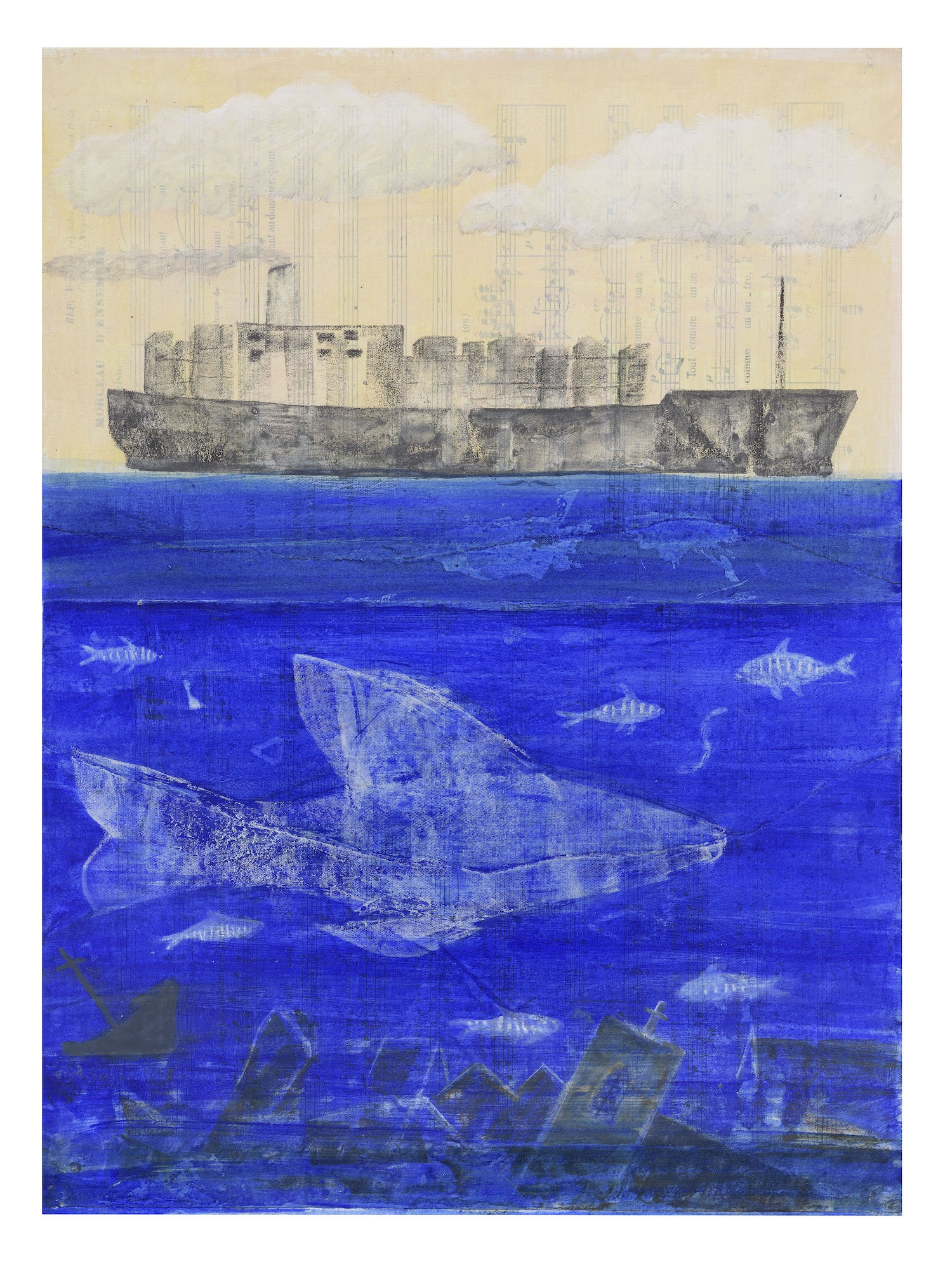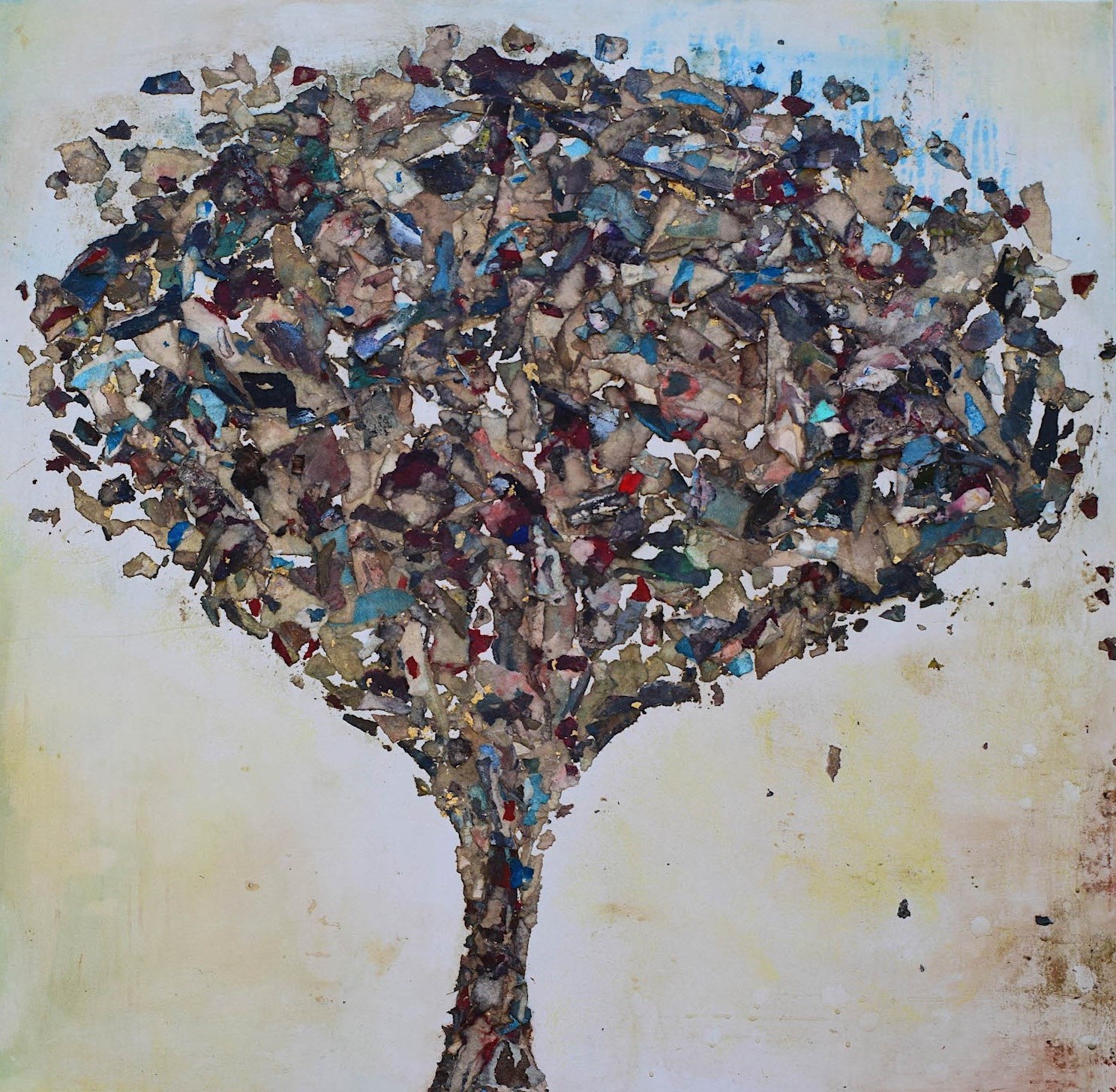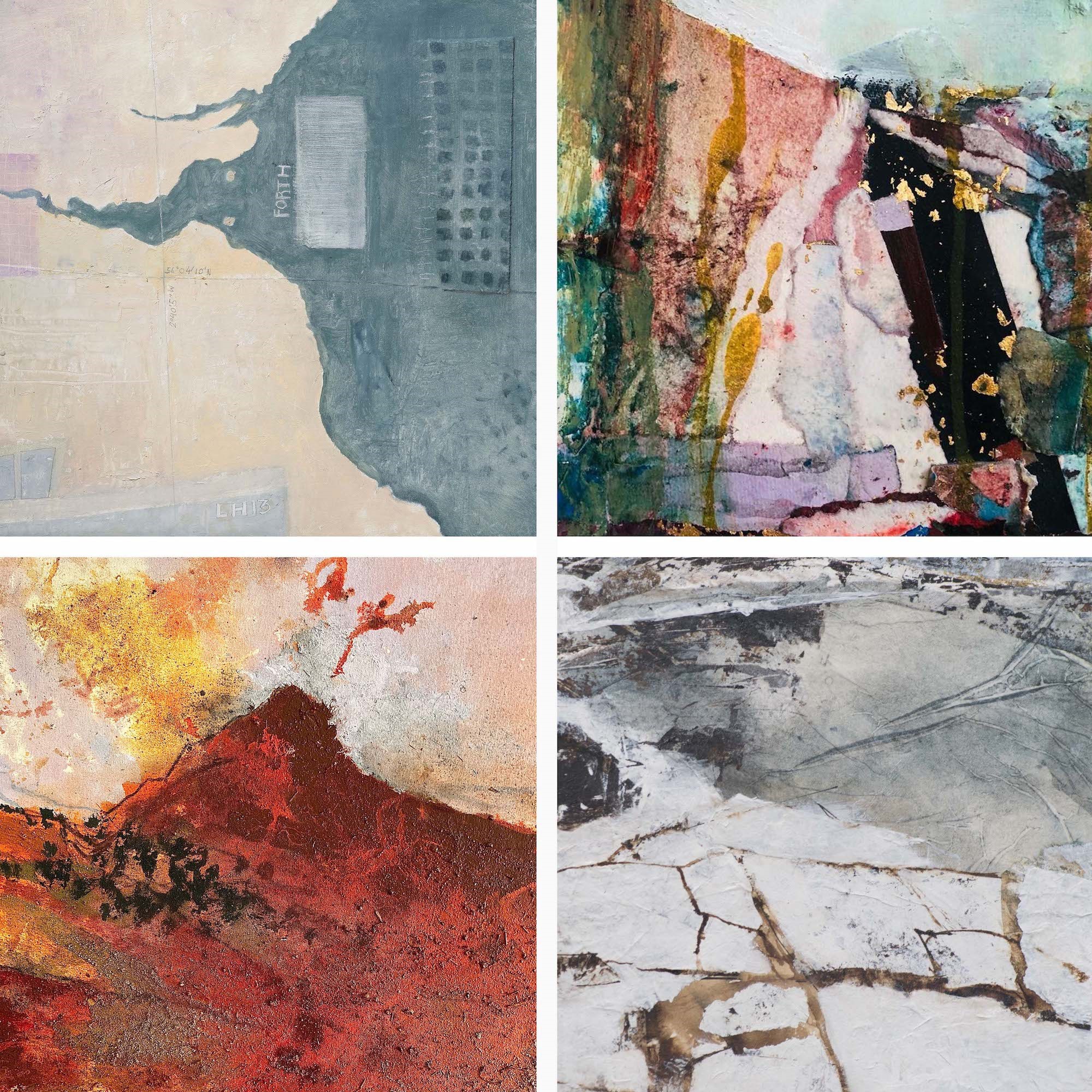
Clockwise from top left: Caroline McAdam Clark RWS, Forth (from the Shipping Forecast), oil on board, Robin Richmond RWS, Mountain Walk # 13, acrylic and gold leaf on paper bonded to canvas, Linda Saul RWS, River Thaw (detail), mixed watermedia on paper on board, Frances Hatch ARWS, QUARRIED AIR – The Bell, Coppermines Valley, Coniston, Cumbria (detail), acrylic and site earths on canvas
Four friends. Four women. Four voices. Four sensibilities. Four artists. Four members of the Royal Watercolour Society.
Frances Hatch, Caroline McAdam Clark, Robin Richmond and Linda Saul's upcoming group exhibition Common Ground will be a four way visual conversation which yields both surprises and moments of recognition. Each artist employs paint and media differently, but what is shared is a deep commitment to their work.
Common Ground is such an impactful title. Why did you choose to focus on mutual understanding and connection with this exhibition and what do you think is the common thread that runs through all of your work?
C: Common Ground was a title that we felt carried a vast variety of interpretations, thereby not pinning us down. Clearly as visual artists we all tread on the common ground of communicating ideas, interpretations, observations, and metaphors drawn from the world about us. At the same time I think we all felt (and this will be seen through our decision to hang the show as 4 individuals) that we needed to approach this exhibition from both perspectives.
R: As well as being Members of the RWS the four of us share a very deep interest in nature and in landscape painting. But the whole is greater than the sum of its parts, and we hope that this show explores how such a time-honoured subject can be opened out in very different ways. The show contains work involving plein air, narrative, observational work and almost complete abstraction. The four of us use the picture surface and our material very differently. It’s fascinating, stimulating and illuminating to see the work hanging together.
Tanker over Dunwich by Caroline McAdam Clark RWS, watercolour, art graf, pencil & chalk on sheet music and board
What do you want the viewer to experience when visiting the exhibition?
F: Paintings begin an independent existence when they leave the studio! But I would like to think visitors will hear four distinct voices within an overall elegant composition.
C: I hope a sense of WOW with some of the paintings, and a tranquil sense of space with others. And wonder, and curiosity. I do hope visitors will engage with every one of us and our various interpretations of place, geology, and mystery.
This exhibition recognises the commonality between all four of you as artists, but it also celebrates the differences in how each of you employ paint and media. How do each of you typically approach a new painting?
L: When I begin a painting, I usually have a rough idea of the composition and a general colour palette in mind. However, I often embrace spontaneous effects, either when applying paint directly to the painting or when creating collage papers. My work is a dynamic interplay between control and risk. At times, I start with no clear vision, responding intuitively to chance effects to develop a pleasing composition. I build the composition up in layers of collage and directly applied paint, sometimes partially tearing or cutting back layers, to achieve rich textural effects. My practice focuses on exploiting the physical properties of acrylics and watercolours, experimenting with their interaction and the influence of various paper surfaces. Collage enables me to combine several techniques in a single work.
R: My work always starts with me being in a particular place at a particular time, hence the specificity of my titles, but I don’t work in a literal way. As I move around the world, I take hundreds of photographs, but I also make watercolour notes in front of the motif, and work from them back in the studio. I have created a huge archive of painted shards of paper, like pieces in a patchwork quilt, and I choose what I need, then I heat the paper returning it to its original pulp state, and fuse the wet paper together, often with gold leaf. I then paint acrylic glazes of colour over these pieces. When I was in Kanazawa in Japan, I learned kintsugi, the method for making a broken pot whole again with streams of gold. Beautiful.
F: I don't set out to 'make a painting'. I begin by setting an intention to spend time within a particular place. I metaphorically 'draw my curtains back' and adopt a stance of present curiosity. It usually takes time for a place to open up, and for me to arrive. I begin to notice things that were not initially available. I'll try out earths and clays, make swatches, gather information about the geology and build what I call a 'place palette'. Paintings arise organically out of paint I bring with me and indigenous tools and 'stuff of place'.
C: I approach my work almost exclusively from the standpoint of the original idea or inspiration. From that I will always construct what amounts to a series based on that initial spark. Hence a series based on a trip to Navaho country exploring not only the astonishing landscape but also the patterns used by the Navaho and the Hopi Indians in Arizona and Colorado; or similarly colours and patterns found in my first working trip to northern India; and more lately focussing on my much loved East Anglian coast and its history.
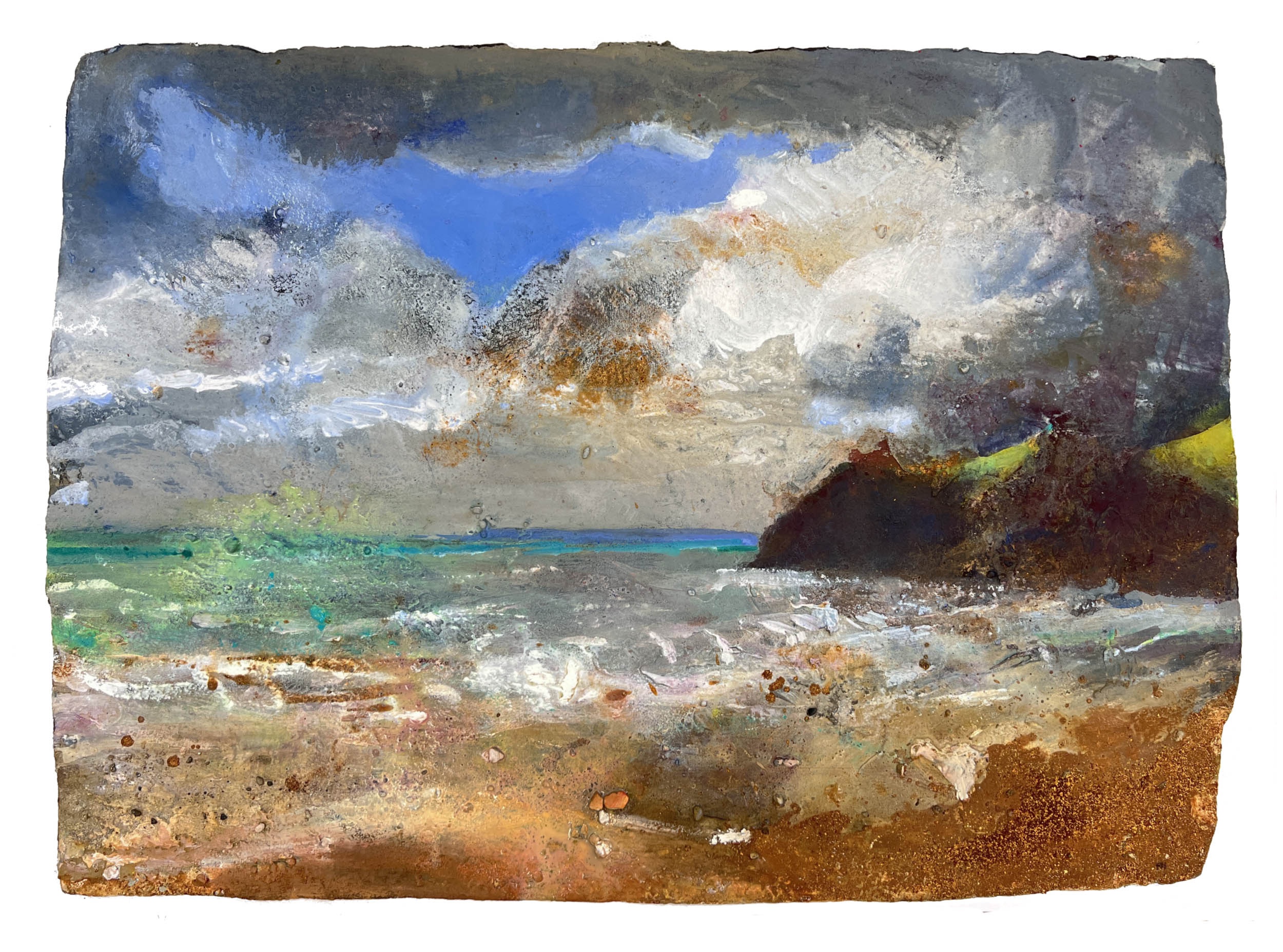
Devon Blue Line. Eype, Dorset by Frances Hatch ARWS, watercolour, acrylic & site earths on handmade cotton rag paper
As you all work from landscape and the natural world, where are some of your favourite places to paint?
L: I’ve developed quite an obsession with Iceland! For the past three years, I’ve been spending several weeks at a time there, either on artist residencies or road trips. I find the Icelandic landscape endlessly inspiring. I don’t usually create final pieces while I’m in Iceland, being separated from my studio and my normal materials. Instead, I focus on making sketches and collecting photographs that serve as references when I’m back in my studio.
F: I'm attracted to flux and threshold, liminal space. These are qualities that inhabit some places more than others. Sometimes works arise out of long relationships with a particular place over years. Sometimes I'm literally stopped in my tracks in unfamiliar territory. There is a bit of both in this exhibition. Each day begins and ends. Weather fronts, precipitation, freeze and breeze move through everywhere. I meet weather participation without prejudice - it isn't a good thing or a bad thing. It simply is. We exist in the midst of dynamic exchange and I hope my work reflects that provisionality.
What inspires you most about each other’s practice?
L: I am in awe of the other three! Frances's profound connection with nature shines through in her work. Some of Robin's works possess a nearly jewel-like quality. Caroline’s works seem to me calm and contemplative.
C: The originality and independence of my fellow artists' interpretation of the world about them.
R: It’s the truthfulness and commitment to their work of my fellow Common Grounders that inspires me the most. It is humbling and educational for me. I am full of admiration.
F: I'm impressed by the clarity of our individual voices, by our commitment to our work.
Elegy I by Robin Richmond RWS, brou de noix & acrylic on canvas
One of your commonalities as artists is your Membership of the Royal Watercolour Society. What does it mean to you to be a Member of the RWS and to be exhibiting in its new RWS Gallery?
L: Becoming a member of the RWS has been a long-standing ambition of mine, and I am truly honoured to have achieved it. The RWS Gallery is a stunning venue for exhibitions, and I am thrilled that my largest exhibition to date will take place here. I'm especially fond of the more intimate space downstairs, which I believe will encourage viewers to engage more deeply with the work.
R: It’s a huge honour to be a member of the Royal Watercolour Society. To be able to show new work four times a year at the Bankside gallery is a privilege and I enjoy the congenial atmosphere of being with fellow artists. In our RWS shows at Bankside we only show works on paper, but here at Whitcomb street it’s a pleasure to include works on canvas.
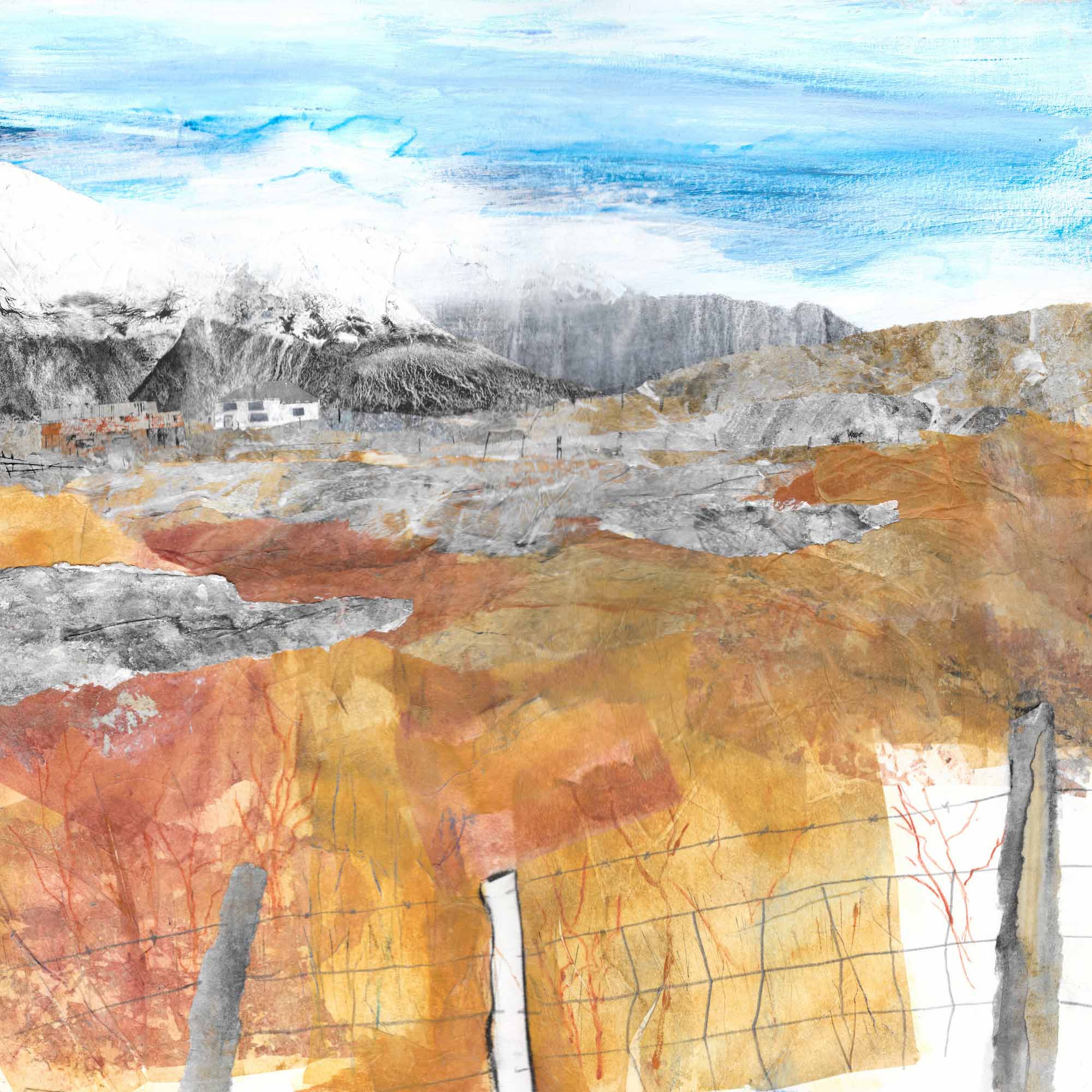
The Farm I by Linda Saul RWS, watermedia collage on paper on cradled panel
Common Ground, Frances Hatch, Caroline McAdam Clark, Robin Richmond and Linda Saul's group exhibition will run from the 10th - 20th October at RWS Gallery.
RWS Gallery
3 - 5 Whitcomb Street
London, WC2H 7HA
Free Admission
Gallery Hours
Open daily 11am - 5pm
For further information about the artists please follow the links below
